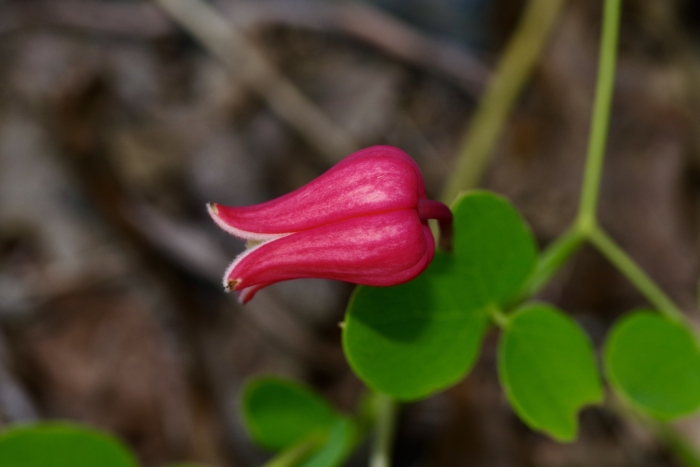Scarlet Leather Flower
(Clematis texensis)
Scarlet Leather Flower (Clematis texensis)
/
/

Michelle W.
CC BY 4.0
Image By:
Michelle W.
Recorded By:
Copyright:
CC BY 4.0
Copyright Notice:
Photo by: Michelle W. | License Type: CC BY 4.0 | License URL: http://creativecommons.org/licenses/by/4.0/ | Rights Holder: Michelle W. | Publisher: iNaturalist | Date Created: 2020-05-08T09:52:03-07:00 |





















































Estimated Native Range
Summary
Clematis texensis, commonly known as Scarlet Leather Flower, is a deciduous perennial vine native to limestone-rich soils in open woodlands and along stream banks in Texas. It can grow to a height of 10-15 feet (3-4.6 meters) and a width of 2-3 feet (0.6-0.9 meters). The vine is known for its distinctive, nodding, urn-shaped flowers with scarlet-colored sepals that bloom from late spring to early fall. The flowers are quite showy, attracting hummingbirds and other pollinators. After flowering, it produces a feathery ball of plumed seeds that add ornamental interest. The plant’s foliage is green and somewhat leathery, adding to its textural appeal.
The Scarlet Leather Flower is valued for its bright, long-lasting blooms and its ability to climb trellises, fences, and other structures, making it a popular choice for vertical interest in gardens. It is also used for naturalizing in wildflower gardens or native plant areas. This Clematis requires well-drained soil, preferably neutral to slightly alkaline, and consistent moisture, though it is drought-tolerant once established. It thrives in full sun to part shade and benefits from mulching to keep its roots cool. Pruning is essential to maintain its shape and promote vigorous growth; it should be pruned in late winter or early spring. While generally disease-resistant, it can be susceptible to Clematis wilt, a fungal disease that causes sudden collapse of the plant.CC BY-SA 4.0
The Scarlet Leather Flower is valued for its bright, long-lasting blooms and its ability to climb trellises, fences, and other structures, making it a popular choice for vertical interest in gardens. It is also used for naturalizing in wildflower gardens or native plant areas. This Clematis requires well-drained soil, preferably neutral to slightly alkaline, and consistent moisture, though it is drought-tolerant once established. It thrives in full sun to part shade and benefits from mulching to keep its roots cool. Pruning is essential to maintain its shape and promote vigorous growth; it should be pruned in late winter or early spring. While generally disease-resistant, it can be susceptible to Clematis wilt, a fungal disease that causes sudden collapse of the plant.CC BY-SA 4.0
Plant Description
- Plant Type: Vine
- Height: 10-15 feet
- Width: 2-3 feet
- Growth Rate: Moderate
- Flower Color: Red
- Flowering Season: Summer, Fall
- Leaf Retention: Deciduous
Growth Requirements
- Sun: Full Sun, Part Shade
- Water: Medium
- Drainage: Medium
Common Uses
Bee Garden, Bird Garden, Border Plant, Butterfly Garden, Deer Resistant, Drought Tolerant, Hummingbird Garden, Rabbit Resistant, Rock Garden, Showy Flowers
Natural Habitat
Limestone-rich soils in open woodlands and along stream banks in Texas
Other Names
Common Names: Crimson Clematis, Scarlet Clematis, Lyktklematis, Texas Clematis, Scarlet Leather-Leaf
Scientific Names: , Clematis texensis, Clematis coccinea var. major, Clematis coccinea var. parviflora, Clematis coccinea var. segreziensis, Clematis texensis f. major, Clematis texensis var. major, Coriflora texensis,
GBIF Accepted Name: Clematis texensis Buckley